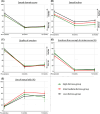The association between pre-diagnostic levels of psychological distress and adverse effects after radical prostatectomy
- PMID: 38751947
- PMCID: PMC11090769
- DOI: 10.1002/bco2.334
The association between pre-diagnostic levels of psychological distress and adverse effects after radical prostatectomy
Erratum in
-
Erratum.BJUI Compass. 2024 Dec 30;5(12):1324-1329. doi: 10.1002/bco2.482. eCollection 2024 Dec. BJUI Compass. 2024. PMID: 39744071 Free PMC article.
Abstract
Objectives: To prospectively analyse the associations between pre-diagnostic levels of anxiety and depression and patient-reported urinary and sexual adverse effects after radical prostatectomy in a population-based setting.
Patients and methods: In three Norwegian county hospitals, men referred with a suspicion of prostate cancer were asked to fill out a patient-reported outcome measurement (PROM) questionnaire prior to prostate biopsy. Those who later underwent radical prostatectomy were stratified into three distress groups according to their Hopkins Symptom Checklist 5-score. Additional PROM questionnaires, including the EPIC-26 to measure adverse effects, were collected at 6 and 12 months postoperatively. Multivariable mixed models were estimated and post hoc pairwise comparisons performed to explore differences in adverse effects between distress groups.
Results: A total of 416 men were included at baseline and of those, 365 (88%) returned questionnaires at 6 months and 360 (87%) at 12 months. After adjusting for confounders, men with high distress at baseline had worse urinary incontinence domain score (58.9 vs. 66.8, p = 0.028), more urinary bother (64.7 vs. 73.6, p = 0.04) and a higher risk of using incontinence pads (70.6% vs. 54.2%, p = 0.034) at 6 months than those with low distress. There was no difference in the sexual domain scores between distress groups postoperatively, but the high-distress group expressed more sexual bother (24.9 vs. 37.5, p = 0.015) and the intermediate-distress group had a greater probability of using sexual medications or devices (63.8% vs. 50.0%, p = 0.015) than the low-distress group at 6 months. At 12 months scores generally improved slightly and differences between distress groups were less evident.
Conclusion: Men with higher levels of anxiety and depression before prostate biopsy report more urinary and sexual adverse effects after radical prostatectomy. This should be considered both in treatment decision-making and during follow-up after radical prostatectomy.
Keywords: anxiety; depression; erectile dysfunction; prostate cancer; radical prostatectomy; urinary incontinence.
© 2024 The Authors. BJUI Compass published by John Wiley & Sons Ltd on behalf of BJU International Company.
Conflict of interest statement
The authors declare no conflicts of interest.
Figures
References
LinkOut - more resources
Full Text Sources


